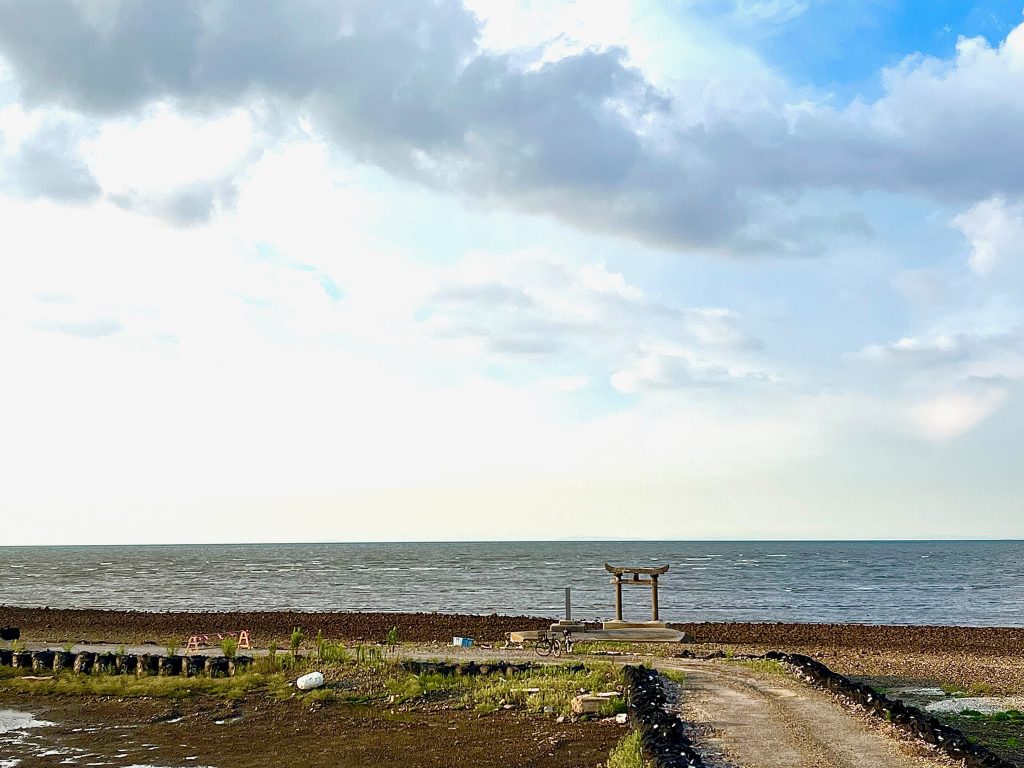by Cornelia Reiher
After a year of online research, I was glad to be back in Japan to do on-site research, and I was fortunate to have so many people to show me around. Thanks to them, I was able to find many differences, not only between the two towns I am researching, but also within the towns. Using my field notes from a Saturday in October, I would like to introduce some of these differences in terms of infrastructure, built environment, and temperature. For this Saturday, I had planned to meet up with a friend and spend the entire day with her. She had told me we were going to the mountains and asked me to bring a sweater because “it’s cold up there”. I was surprised because it was still 25 degrees, but packed the warm clothes anyway.

Impression of the cityscape in the city center
Copyright © Cornelia Reiher 2022
First, we stayed in the compact old town and walked to a restaurant I had visited before when I was in town a few years ago. The place used to be a public bath and is now used as a café, restaurant and gallery. Diners sit in the former pool of the bath or in the gallery, where new artwork is always on display. The operators had closed the place during the Corona crisis, but recently their café was featured in a television program about original cafés in unusual places and has been doing quite well ever since. My friend had invited the owner of a cab company and real estate firm who is also working to revitalize the city. He told us that he has problems finding cab drivers. But many old people depend on cabs when they need to go to the doctor or shopping. The municipality subsidizes cab rides for the elderly.

Lunch in a former public bath
Copyright © Cornelia Reiher 2022
After a delicious lunch, we took the car and I quickly realized that you need a car to get around the town. Our next stop was an exhibition opening at the gallery I featured in my last blog post. To get there, we drove for about twenty minutes through pre-harvest golden rice fields before turning into a small hamlet with an old shrine and many abandoned houses. It was a stark contrast to the beautifully renovated town center with its stores, restaurants, cultural institutions and supermarket within walking distance of the train station. Due to a municipal merger during the Great Heisei Merger (heisei no daigappei), the town’s area is now very large and it is difficult to reach all the hamlets without a car. The towns and hamlets have also preserved their local identities and customs. This was evident when we saw the preparations for the various Kagura performances that took place at the local shrines on the same weekend, organized by local groups. And even the music that comes from the public loudspeakers in the morning and evening is different in each district.

The Kagura stage in a small shrine in one of the hamlets we visited that day
Copyright © Cornelia Reiher 2022
Our next stop after the opening was my friend’s house, which is in another part of town in the mountains. It was another fifteen-minute drive. The sky looked beautiful on this still very warm day, but when we stopped at my friend’s small house and exited the car, I was shocked at the difference in temperature. I was glad I had brought the sweater, but my friend warned me that it would be even colder at our next stop: a campsite up in the mountains. On the way to the campsite, we saw the mountains, passed greenhouses, cattle pens, and vegetable fields. When we pulled into the camp ground parking lot after another twenty minutes of driving, the sun was just setting behind the mountains.

The plateau and the mountains in the background form a beautiful scenery
Copyright © Cornelia Reiher 2022
The campsite is located in a flowery meadow on a plateau with a breathtaking view of the mountains. We had come to meet a friend who had organized a lantern festival at the campsite. Although, as my friend warned me, it was even colder up there, the camp ground was full of tents and cars from all over Japan. Guests were camping out and had brought their lanterns and mini kerosene stoves. The lanterns were set up on a platform and lit. When we arrived, most people were sitting in front of their tents eating in the glow of the lanterns in the twilight. The darker it got, the more beautiful it looked. We were allowed to look inside many tents. Some were set up like a real living room, with record players and speakers, and the true meaning of glamping became clear to me.

The campground is located in a flowery meadow on a plateau and people lit up their lanterns when it got dark
Copyright © Cornelia Reiher 2022
When it was completely dark and all the lanterns were burning, the temperature had dropped to twelve degrees. Since we were completely frozen, we decided to go to a hot spring to warm up. The full moon and stars provided little light, and we needed a flashlight to find my friend’s car on the way back. After another twenty-minute drive, we arrived at the onsen. We bathed in the hot water of the outdoor pool, from which we could see the full moon, and struck up a conversation with an old lady. When my friend drove me back to the town center, I noticed that it was much warmer there. Nevertheless, we bought oden, a typical winter food, and found that it was the perfect ending to this adventurous day.



































